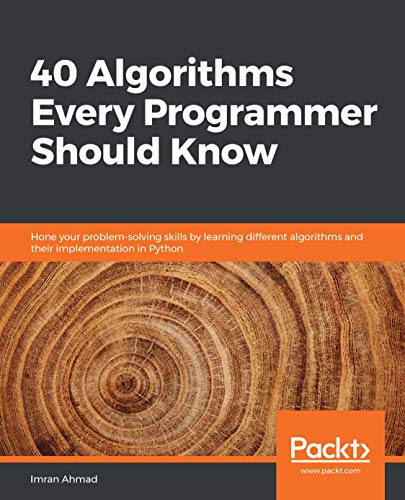40 Algorithms Every Programmer Should Know: Hone your problem-solving skills by learning different algorithms and their implementation in Python Link to heading
Summary Link to heading
“40 Algorithms Every Programmer Should Know” by Imran Ahmad provides a comprehensive guide to essential algorithms vital for modern software development and computer science. The book focuses on enhancing problem-solving skills by teaching the implementation of these algorithms in Python. Topics include classic algorithms, such as sorting and searching, as well as more complex concepts like graph theory, dynamic programming, and machine learning algorithms. Through practical examples and implementations, the book aims to equip readers with the fundamental knowledge to apply these algorithms effectively in real-world applications.
Review Link to heading
Imran Ahmad’s book serves as a valuable resource for both novice and experienced programmers. It bridges theoretical concepts and practical applications, making complex topics accessible through clear explanations and Python examples. While the book excels in offering a wide range of algorithms, its depth on each topic may vary, potentially leaving some readers seeking deeper exploration of specific algorithms. Nevertheless, its structured approach and focus on Python implementations make it a suitable tool for those looking to strengthen their understanding of algorithms.
Key Takeaways Link to heading
- Diverse Algorithm Coverage: The book presents a mix of classic and modern algorithms essential for various programming tasks.
- Python Implementations: Practical coding examples in Python help solidify understanding and demonstrate real-world applications.
- Problem-Solving Focus: Emphasizes honing problem-solving skills critical for software development and technical interviews.
- Breadth over Depth: Provides a broad overview suitable for general learning, though some may require additional resources for in-depth exploration.
Recommendation Link to heading
This book is highly recommended for aspiring software developers, computer science students, and seasoned programmers looking to refresh their algorithm knowledge. It is particularly useful for those preparing for coding interviews or seeking to improve their problem-solving abilities using Python. By focusing on widely applicable algorithms, the book serves as both a learning tool and a quick reference guide.
Highlights of Key Algorithms Link to heading
1. Dijkstra’s Algorithm Link to heading
Why It’s Useful: Dijkstra’s Algorithm is essential for finding the shortest path between nodes in a graph, crucial for applications in network routing, mapping, and game development. This algorithm optimizes pathfinding by calculating the shortest route through connected nodes, such as cities on a map or routers in a network.
Problems It Solves: Dijkstra’s Algorithm is ideal for distance optimization problems like finding the shortest route for delivery drivers or identifying the quickest path in a game environment. It reduces unnecessary computations, making it efficient for pathfinding tasks.
How the Author Explains It: Ahmad explains Dijkstra’s Algorithm step-by-step with a relatable example of cities connected by roads. This practical approach, combined with Python code snippets, helps readers grasp the logic and implementation. Real-world analogies make a potentially intimidating algorithm approachable and memorable, especially for beginners.
2. Dynamic Programming (DP) Link to heading
Why It’s Useful: Dynamic Programming (DP) is a key technique for solving complex problems by breaking them down into overlapping subproblems. This method is especially useful in optimization scenarios, including finance, operations, and bioinformatics, where efficiency is essential.
Problems It Solves: DP solves problems related to optimization, like minimizing costs, maximizing profits, or finding the longest sequence. For instance, the “Knapsack Problem,” a classic DP example, involves choosing items to maximize value within a weight limit.
How the Author Explains It: Ahmad introduces DP by first explaining the brute-force approach, highlighting its limitations, then gradually leading readers to the optimized DP solution. This contrast helps readers appreciate DP’s power and encourages them to think critically about problem structure and strategy.
3. A Search Algorithm* Link to heading
Why It’s Useful: A* Search combines Dijkstra’s and Greedy Best-First Search principles, making it popular in AI and robotics for pathfinding and navigation. It uses heuristics to estimate the best path, balancing cost-effectiveness and speed.
Problems It Solves: A* is widely used in applications needing efficient and accurate pathfinding, like GPS navigation systems, autonomous vehicle routing, and game AI navigation around obstacles. Its heuristic-driven approach speeds up searches, making it more efficient than standard pathfinding algorithms in complex environments.
How the Author Explains It: Ahmad explains A* by comparing it to other pathfinding algorithms, setting a strong foundation for understanding its efficiency. He provides examples and Python code, guiding readers step-by-step, which makes a potentially complex algorithm much more approachable.
Why Ahmad’s Approach Stands Out Link to heading
Imran Ahmad’s explanations are well-paced and grounded in practical examples, making complex algorithms easier to grasp. His use of Python allows readers to quickly implement each concept, and his examples strike a perfect balance—not too trivial, but not overly complex. The combination of theory, visuals, and code is where the book truly shines, giving readers a comprehensive understanding of each algorithm.
Whether you’re preparing for a coding interview, improving your software engineering skills, or exploring new problem-solving techniques, “40 Algorithms Every Programmer Should Know” offers valuable insights and practical tools that will strengthen your algorithmic foundation and confidence.
